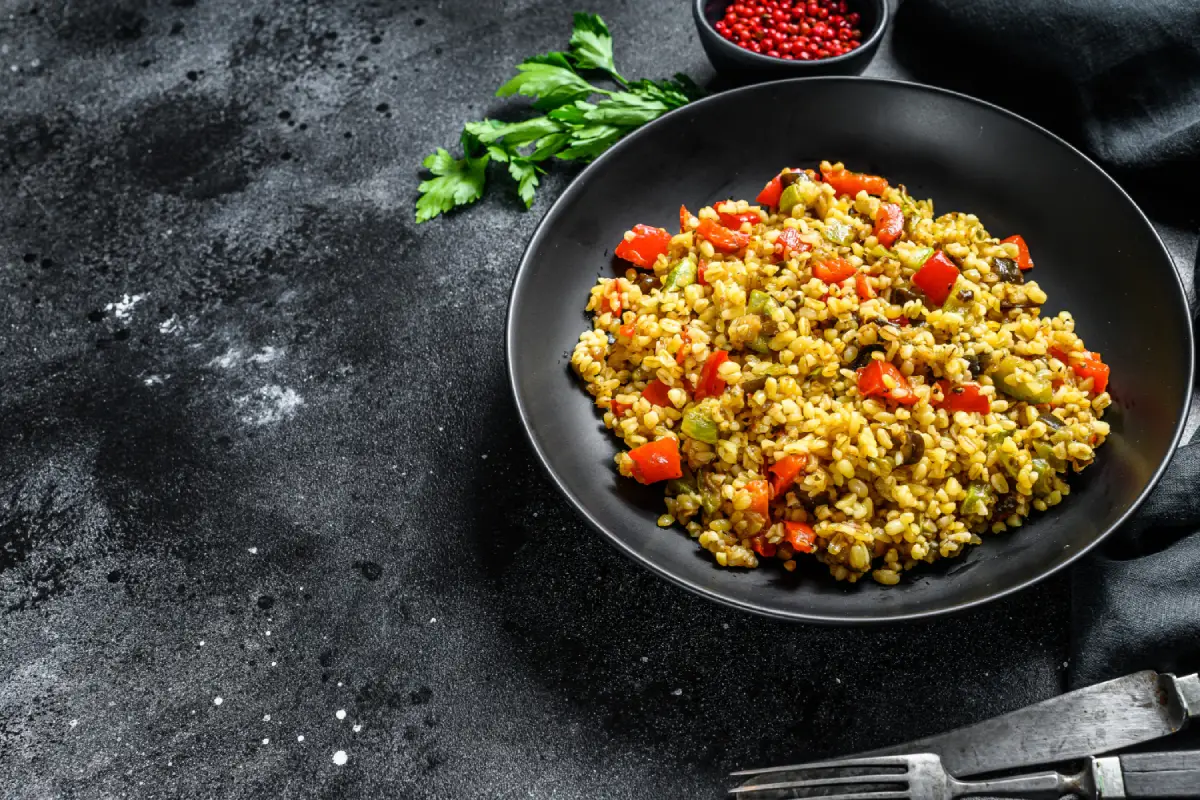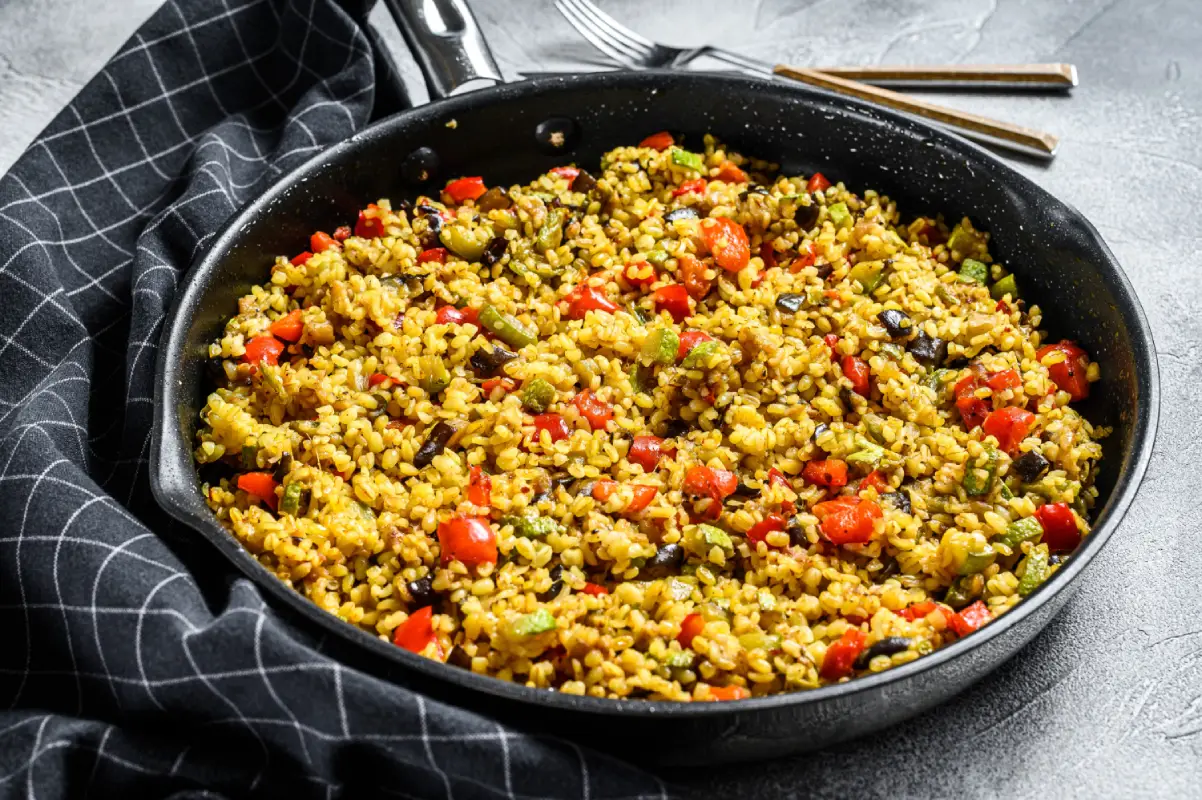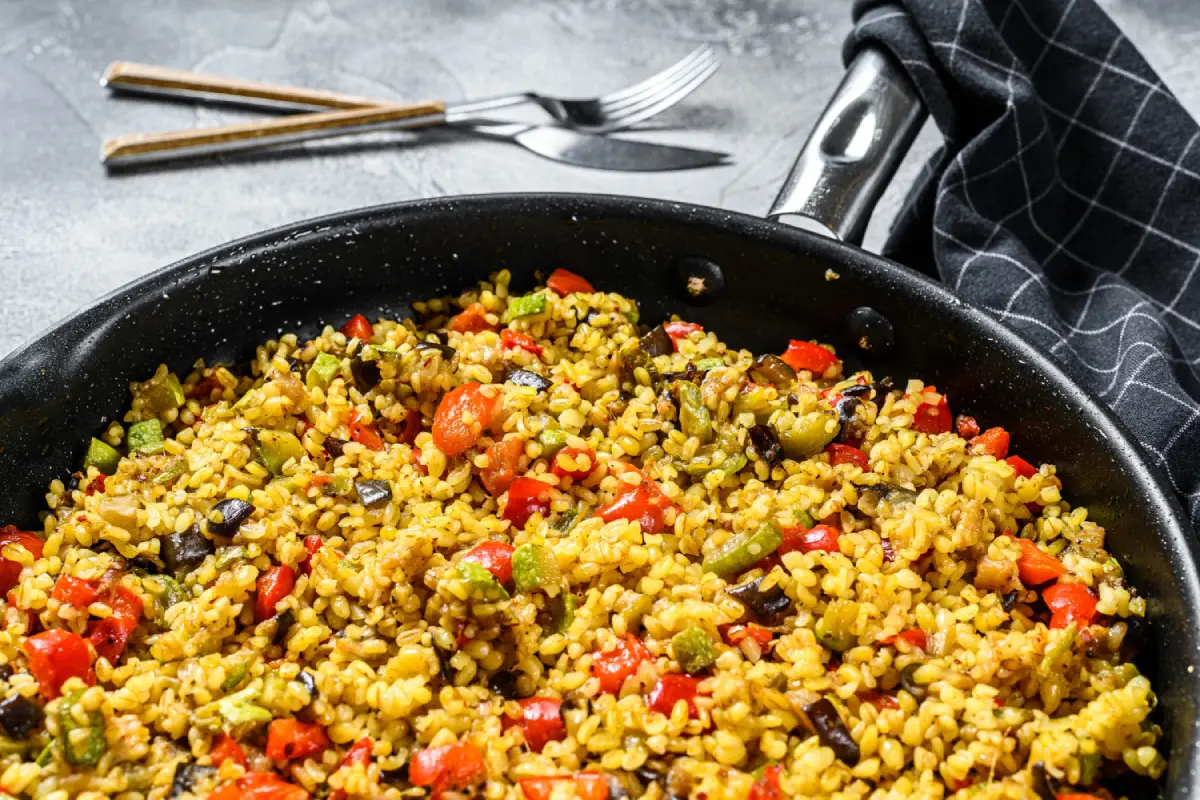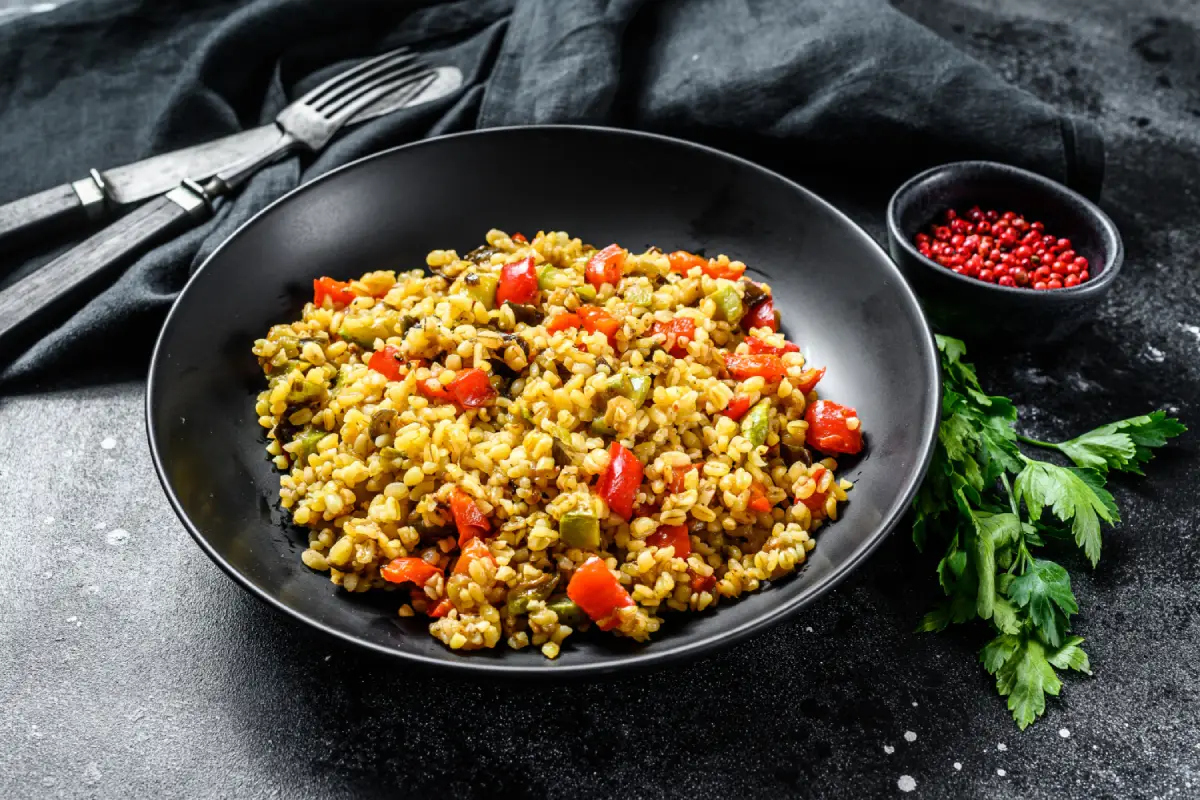Dive into the world of bulgur, a nutritious grain that brings a nutty flavor and versatile texture to your table. Our Healthy Bulgur with Vegetables Recipe is a celebration of simplicity, nutrition, and taste, perfect for anyone looking to enrich their diet. Whether you’re a kitchen novice or a culinary enthusiast, this guide is your ticket to a delicious, wholesome meal that combines the earthy goodness of bulgur with the fresh, vibrant flavors of vegetables. Get ready to explore the essentials of cooking with bulgur, from choosing the right type to pairing it with the best seasonal veggies, all while unlocking the secrets to a dish that’s as nourishing as it is delightful.
What is Bulgur?

Bulgur is a whole grain made from cracked wheat, primarily from durum wheat, that has been partially cooked, dried, and then cracked. This process not only shortens the cooking time but also retains the grain’s nutritional value and gives it a distinctive, nutty flavor and a satisfying, chewy texture. Bulgur is a staple in Middle Eastern cuisine, celebrated for its versatility in dishes ranging from pilafs and salads to soups and stuffed vegetables.
Nutritional Profile
Bulgur stands out in the whole grain family for its impressive nutritional content. It’s high in fiber and protein, yet low in fat and calories, making it an excellent choice for those looking to maintain or achieve a healthy weight. Bulgur is also rich in vitamins and minerals, including B vitamins, iron, magnesium, and manganese, contributing to overall health and well-being.
Why Choose Bulgur?
Choosing bulgur as part of your diet offers numerous benefits. Its high fiber content supports digestive health and helps regulate blood sugar levels, making it a smart choice for people with diabetes. The grain’s rich nutrient profile supports heart health and can contribute to reducing inflammation. Additionally, bulgur’s quick cooking time and versatile nature make it an easy and convenient grain to incorporate into your daily meals, providing a satisfying base that can be easily adapted to a variety of flavors and ingredients.
In our journey to create a healthy and flavorful bulgur with vegetables dish, understanding the foundation—the grain itself—is key. Next, we’ll delve into the health benefits of bulgur, further highlighting why this grain deserves a place in your kitchen.
The Health Benefits of Bulgur
Bulgur isn’t just a versatile and delicious grain; it’s also packed with a myriad of health benefits that make it a superb choice for anyone looking to enrich their diet. Here’s a closer look at why bulgur is a nutritional powerhouse:
Rich in Dietary Fiber
Bulgur is high in dietary fiber, which is essential for digestive health. Fiber helps to keep the digestive system running smoothly, prevents constipation, and can aid in weight management by making you feel fuller longer. Additionally, a diet rich in fiber has been linked to a lower risk of chronic diseases, including heart disease and type 2 diabetes.
Promotes Heart Health
The fiber in bulgur is not only good for digestion but also plays a role in heart health. It helps to lower bad cholesterol levels, thereby reducing the risk of heart disease. Bulgur also contains magnesium, a mineral that helps regulate blood pressure, further supporting cardiovascular health.
Stabilizes Blood Sugar Levels
For those managing diabetes or looking to maintain stable blood sugar levels, bulgur is an excellent food choice. Its high fiber content slows down the absorption of sugar into the bloodstream, preventing spikes in blood sugar levels and helping to manage diabetes.
Provides Plant-Based Protein
Bulgur is a good source of plant-based protein, making it an excellent addition to vegetarian and vegan diets. Protein is crucial for building and repairing tissues, supporting immune function, and promoting overall health.
Loaded with Vitamins and Minerals
In addition to fiber and protein, bulgur is rich in an array of vitamins and minerals. It’s a good source of B vitamins, particularly B6, which plays a vital role in energy metabolism and the production of neurotransmitters. Bulgur also provides significant amounts of iron, magnesium, and manganese, essential nutrients that support various bodily functions from oxygen transport to bone health.
Supports Weight Management
Due to its high fiber content and nutritional density, bulgur can be a beneficial part of a weight management or loss plan. It provides a feeling of fullness with fewer calories, making it easier to control portion sizes and avoid overeating.
Incorporating bulgur into your meals not only brings a delightful texture and taste but also contributes to a balanced, nutritious diet. As we explore how to combine this wholesome grain with a variety of vegetables, we’re not just creating a meal; we’re crafting a dish that supports a healthy lifestyle. Next, we’ll guide you through choosing the right type of bulgur for your dish, ensuring your culinary creations are both delicious and nutritious.
Choosing the Right Type of Bulgur for Your Dish
Bulgur comes in various grades, from fine to coarse, each suited for different types of dishes. Understanding the distinctions can help you choose the right type for your healthy bulgur with vegetables recipe, ensuring the texture and cooking time match your meal’s needs.
Fine Bulgur
Fine bulgur cooks quickly, absorbing flavors well, making it perfect for salads like tabbouleh or dishes that don’t require extensive cooking. Its light texture complements the crispness of fresh vegetables, making it a great choice for cold salads.
Medium Bulgur
Medium bulgur is the versatile middle ground, suitable for a wide range of dishes, including pilafs, soups, and stuffings. It offers a balance between absorbing flavors and maintaining its distinct texture, making it ideal for our featured recipe.
Coarse Bulgur
Coarse bulgur takes the longest to cook but provides a robust texture that’s excellent for hearty dishes like stews or as a meat substitute in vegetarian or vegan recipes. It’s ideal for when you want the bulgur to stand out as a substantial part of the meal.
Choosing Based on Dish Type
- Salads and Cold Dishes: Opt for fine bulgur, which will soften easily without needing much heat.
- Warm Side Dishes and Pilafs: Medium bulgur is your best bet, offering a pleasant texture that’s neither too soft nor too chewy.
- Hearty Meals and Stews: Choose coarse bulgur, which holds up well during longer cooking times and provides a satisfying chew.
Experiment with Textures
Don’t be afraid to experiment with different grades of bulgur to find your personal preference. Sometimes, a slight adjustment in texture can make a familiar dish feel entirely new.
Understanding the types of bulgur and their best uses allows you to craft dishes that are not only delicious but also perfectly textured. As we move on, we’ll explore the vegetable pairings that can elevate your bulgur dish from good to extraordinary, emphasizing the harmony between grains and greens.

Perfect Vegetable Pairings for Bulgur
Pairing bulgur with the right vegetables can transform your dish into a vibrant, nutritious, and flavorful meal. The earthy, nutty taste of bulgur complements a wide range of vegetables, from leafy greens to hearty roots. Here’s how to choose and pair vegetables with bulgur for the best culinary experience:
Leafy Greens
Spinach, kale, and Swiss chard bring a touch of freshness and a wealth of vitamins to the bulgur. Their slight bitterness contrasts nicely with its nuttiness, especially when they’re just wilted and retain a bit of their crunch.
Roasted Vegetables
Roasted vegetables like bell peppers, zucchini, eggplant, and cherry tomatoes add a sweet and smoky flavor that pairs beautifully with bulgur. Their caramelized edges and tender insides make the dish more substantial and satisfying.
Crunchy Raw Veggies
Adding raw vegetables such as cucumber, radishes, or scallions can introduce a delightful crunch and freshness to the dish, making it perfect for a light lunch or side salad. Their crisp texture and burst of flavor freshen up the whole meal.
Hearty Roots
For a heartier, comforting dish, pair bulgur with roasted or steamed root vegetables like carrots, sweet potatoes, or beets. These vegetables add a natural sweetness and robustness, making the meal more filling and suitable for colder months.
Herbs and Citrus
Don’t forget to enhance your bulgur and vegetable dish with fresh herbs like parsley, cilantro, or mint, and a squeeze of lemon or lime juice. These add a layer of brightness and zest, tying all the flavors together beautifully.
Cooking Techniques
- Roasting brings out the natural sweetness in vegetables, which complements the nuttiness of bulgur.
- Steaming preserves the crisp texture and vibrant color of vegetables, making your dish visually appealing and nutritionally rich.
- Sautéing quickly in olive oil with garlic or onions can add depth to both the vegetables and bulgur, infusing them with savory flavors.
When selecting vegetables to pair with bulgur, consider the balance of flavors, textures, and colors to create a dish that’s as appealing to the eye as it is to the palate. The versatility of bulgur makes it a perfect canvas for experimenting with seasonal vegetables, allowing you to adapt this dish to whatever is fresh and available.
Next, we’ll explore the art of mastering the cooking techniques for bulgur, ensuring you get perfectly cooked grains every time as the base of your vegetable dish.
Mastering the Cooking Techniques for Bulgur
Cooking bulgur to perfection is simpler than you might think, but knowing a few key techniques can ensure your grains are always just right – fluffy, tender, and full of flavor. Here’s how to master the art of cooking bulgur, whether you’re aiming for a light side dish or a hearty main.
Basic Cooking Method
- Ratio: Start with a basic water-to-bulgur ratio of about 2:1. This means for every cup of bulgur, you’ll need two cups of water. Adjustments might be needed depending on the bulgur type.
- Boiling: Bring water to a boil in a medium saucepan. You can add a pinch of salt for flavor.
- Adding Bulgur: Once the water is boiling, add your bulgur and stir. Cover the saucepan with a lid.
- Simmering: Reduce the heat to a simmer and let the bulgur cook until it absorbs all the water. This usually takes about 10-15 minutes for medium to coarse bulgur. Fine bulgur may need less time.
- Resting: After the bulgur has absorbed the water, remove it from the heat but keep it covered. Let it sit for about 5-10 minutes. This step allows the grains to steam and become fluffy.
- Fluffing: Use a fork to fluff the bulgur, breaking up any clumps and allowing some steam to escape.
Tips for Perfect Bulgur
- Toasting: For an added nutty flavor, you can toast the bulgur in a dry pan or with a little oil before adding water. This step deepens its flavor and adds a delightful aroma to your dish.
- Broth Instead of Water: For extra taste, cook bulgur in vegetable or chicken broth. This infuses the grains with more flavor, making your dish even more delicious.
- Cold Water Soak: Fine bulgur doesn’t always need to be cooked. It can simply be soaked in cold water for about 30 minutes to an hour until it’s tender, perfect for salads.
- Microwave Cooking: Bulgur can also be cooked in the microwave. Combine water and bulgur in a microwave-safe bowl, cover, and cook on high power, checking for doneness and stirring occasionally.
Mastering these simple cooking techniques for bulgur will ensure you have a perfectly prepared base for any number of delicious dishes, from salads to hearty, vegetable-rich meals. Next, we’ll dive into the art of seasoning your bulgur and vegetable creations, adding layers of flavor that transform simple ingredients into extraordinary meals.
Seasoning Bulgur: Tips and Ideas
The magic of a bulgur dish often lies in its seasoning. While bulgur has a pleasant, nutty flavor on its own, the right seasonings can elevate it from a simple grain to a standout dish. Here’s how to infuse your bulgur and vegetable dishes with flavors that will make them come alive.
Basic Seasonings
- Salt and Pepper: Start with the basics. A good seasoning foundation begins with salt and pepper, adjusting to taste.
- Olive Oil: A drizzle of quality olive oil can add richness and depth to the dish, enhancing the natural flavors of both bulgur and vegetables.
Herbs and Spices
- Fresh Herbs: Incorporate herbs like parsley, cilantro, mint, or dill for freshness. Each herb can offer a unique flavor profile, from the bright notes of parsley to the coolness of mint.
- Dried Spices: Experiment with spices such as cumin, coriander, paprika, or turmeric. These can add warmth, color, and complexity to your dish. A pinch of cinnamon or allspice can also introduce an unexpected but delightful flavor.
Citrus and Vinegar
- Lemon or Lime Juice: The acidity from lemon or lime can brighten the entire dish, enhancing the other flavors and adding a refreshing note.
- Vinegars: A splash of balsamic, red wine, or apple cider vinegar can add a subtle tanginess that complements the earthiness of bulgur and the sweetness of roasted vegetables.
Umami Boosters
- Soy Sauce or Tamari: For a deeper flavor, a small amount of soy sauce or tamari can introduce an umami element that balances well with the grain’s nuttiness.
- Nutritional Yeast or Parmesan: Sprinkle nutritional yeast or grated Parmesan over your finished dish for a cheesy, umami-packed finish.
Customizing Your Seasoning
The key to successfully seasoning bulgur is to taste as you go and adjust according to your preferences. Don’t be afraid to mix and match herbs, spices, and acids to find the combination that works best for you. Remember, the vegetables you choose will also influence the overall flavor profile, so consider how their tastes will blend with the seasonings you select.
Bringing It All Together
Once your bulgur is cooked and your vegetables are prepared, gently mix them together, adding your chosen seasonings a little at a time. This step is not just about combining ingredients; it’s about creating harmony between the textures of bulgur and vegetables and the flavors of your seasonings. Let the dish sit for a few minutes before serving to allow the flavors to meld together beautifully.
Seasoning is both an art and a science. By understanding the impact of each ingredient, you can transform your bulgur and vegetable dish into a memorable meal that’s packed with flavor and nutrition. Next, we’ll explore ways to incorporate bulgur with vegetables into your meals, ensuring variety and excitement in your culinary routine.

Mastering the art of creating delicious, healthy bulgur with vegetables is a rewarding journey into the heart of wholesome cooking. This dish, with its rich flavors and nutritious profile, stands as a testament to the beauty of simple ingredients coming together in perfect harmony. As you embrace the versatility of bulgur and the vibrant freshness of seasonal vegetables, remember that every meal is an opportunity to nourish both body and soul.
But the adventure doesn’t have to stop here. Continue exploring the culinary world with these specially curated guides, each designed to enhance your cooking repertoire:
- Dive into Comfort: Lentil Cream Soup Recipe Guide – For those chilly evenings or when you crave something comforting and heartwarming, our lentil cream soup is a hug in a bowl.
- Crispy Fried Chicken Guide – Indulge in the ultimate comfort food with our guide to making crispy, juicy fried chicken that promises to be a hit at any gathering.
- Healthy Roasted Fish with Seasonal Vegetables and Lemon Recipe: A Culinary Delight – Elevate your dining experience with this guide to creating a deliciously healthy roasted fish dish, showcasing the best of seasonal produce.

